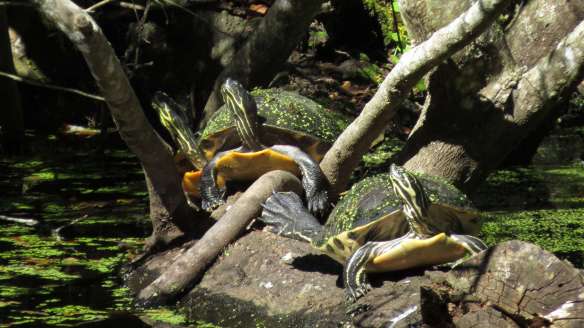Florida: Weedon Preserve, Sawgrass Park, and Seminole Lake
One of the highlights of my trip to Florida was birding with my dad.

He lives in Largo and his birding enthusiasm is a close match to mine. In the past year since I started birding, we’ve have a blast quizzing each other by emailing pictures of birds we can’t see in our respective areas.
He sends me pictures of Limpkins (baby Limpkins!), Red-bellied Woodpeckers, Yellow-crowned Night Herons, and Brown Thrashers harassing snakes. If there were any reason to visit Florida, these would be it. A handful of his pics:
He had a few spots picked out for us to see during my trip, including Weedon Island Preserve, a 3,700 acre preserve complete with a cultural and natural history center, trails, boardwalks (AKA Raccoon Highway), mangroves, wetlands, uplands, crabs (!) (Mangrove Tree Crab).
And birds! A whole lot of them.
Of course it wasn’t that easy. They made us work for it. We showed up promptly at sunrise for low tide and there were no birds in sight. It wasn’t until the day warmed up that they came out to feed. Once they did, we saw Great Egrets, White Ibis, Snowy Egrets, and many more wading birds in the distance. And a Wood Stork flew overhead. It was a good time.
The best part of Weedon Island though, was a moment that’ll go down in my book of birding history. After striking out on birds first thing in the morning, my dad and I rounded the corner to another overlook and found an unbelievable sight. A Roseate Spoonbill closely followed by a Tricolored Heron buddy. The wait was worth it.
My dad describes Tricolored Herons as Little Blue Herons that’ve had too much coffee. Little blues stand still and intensely stalk prey (much like the Great Blue Heron), while Tricolors dart quickly back and forth in the water gathering up fish and bits of food. It’s a useful behavioral clue to identify them. We watched this one pick up bits the spoonbill stirred up. They made quite the pair.

Shortly after, the spoonbill posed nicely for us and my day was made.
Gorgeous wrinkly spoon face!
We went to Sawgrass Lake Park next. Surrounded by “the most densely populated county in Florida” (Pinellas County), the 400 acre park is a haven for wildlife. Especially alligators. We saw three of them. Florida wildlife sighting Level-Up.
And the obligatory “no molesting” the gators sign. So many feels. So many jokes. It’s too easy.
This park had a few gems besides gators and funny gator signs. Including adorable Little Blue Herons. So intense. So cute.
And the most fun bird to say, Anhinga (an-HIN-ga)! With many nicknames: it’s called the Water-Turkey thanks to its tail and swimming habits, and also Snake-Bird because it often swims with just its head sticking out of the water. We saw several of them, usually sunning themselves since this species lacks oils that make feathers waterproof. Anhinga anhinga is named from Tupi Indian (Brazil) language. AnHINga!
We also saw Common Gallinule (gal-li-NOO-l) and heard it’s cackling and yelping calls. The species was split from Common Moorhen (Old World) in 2011 by the AOU.
Upon leaving this park, we saw a neat grouping of three species together, Tricolored Heron in the far back, a Little Blue Heron front left, and three White Ibises!
And a softshell turtle.
Our final destination was Seminole Lake Park. The best trails in this park wind through pine flatwoods where we saw several species of birds. Some familiar, some new.
And a whole bunch more.
Funny thing about this park, we actually visited several mornings in search of what turned out to be my “nemesis bird” of the trip, the Limpkin! My dad sees them here frequently, but I missed out this time. Good to have a reason to return. Next time!
We ended the search on a high note with a good look at this remarkable creature, the Wood Stork.
If I keep writing about Florida will that make it sunny in Portland?!
Too bad this post pretty much sums up my awesome trip. Thanks for following along!
Happy turtles,
Audrey






























































Why is it named red bellied when it’s actually red headed?!?
There’s a small red smudge on the far underside of the belly that’s barely visible! It should be called a Red-Smudged-White-Bellied-Red-Headed Woodpecker!
Really fun to follow along on your trip. Thanks for the tour!
[…] ← Previous […]
[…] I birded almost every day on this trip. It’s nice he shares a fondness of feathers. And since last time I left without finding Limpkins, this time he took time scouting parks for potential. He found Circle B […]